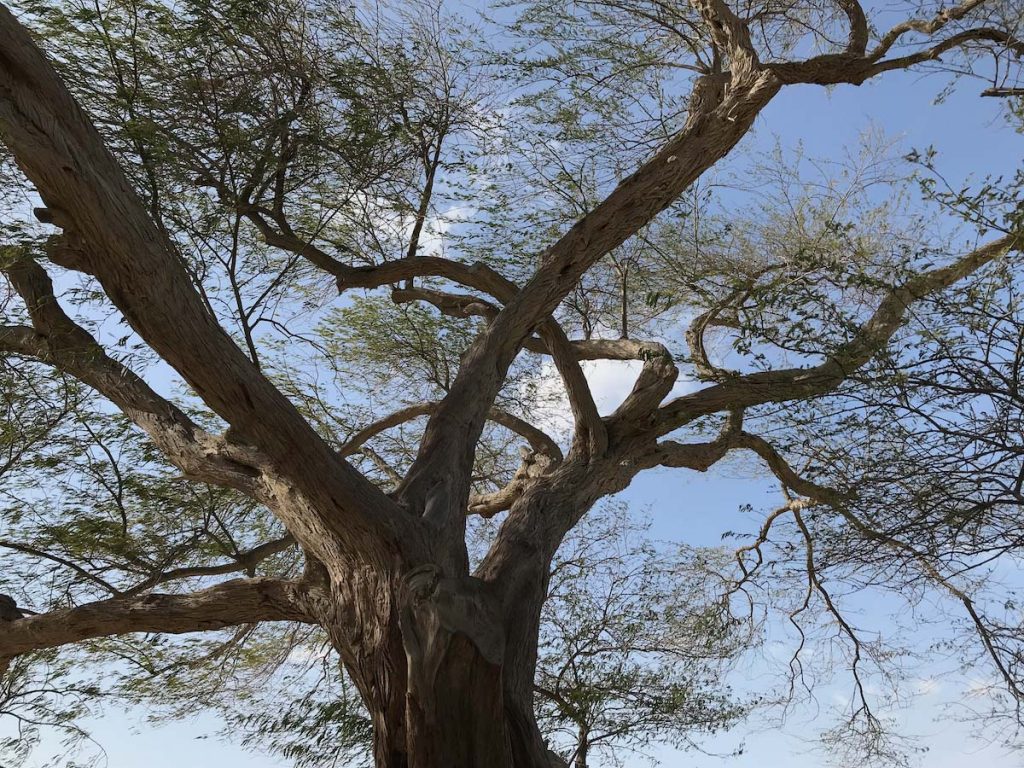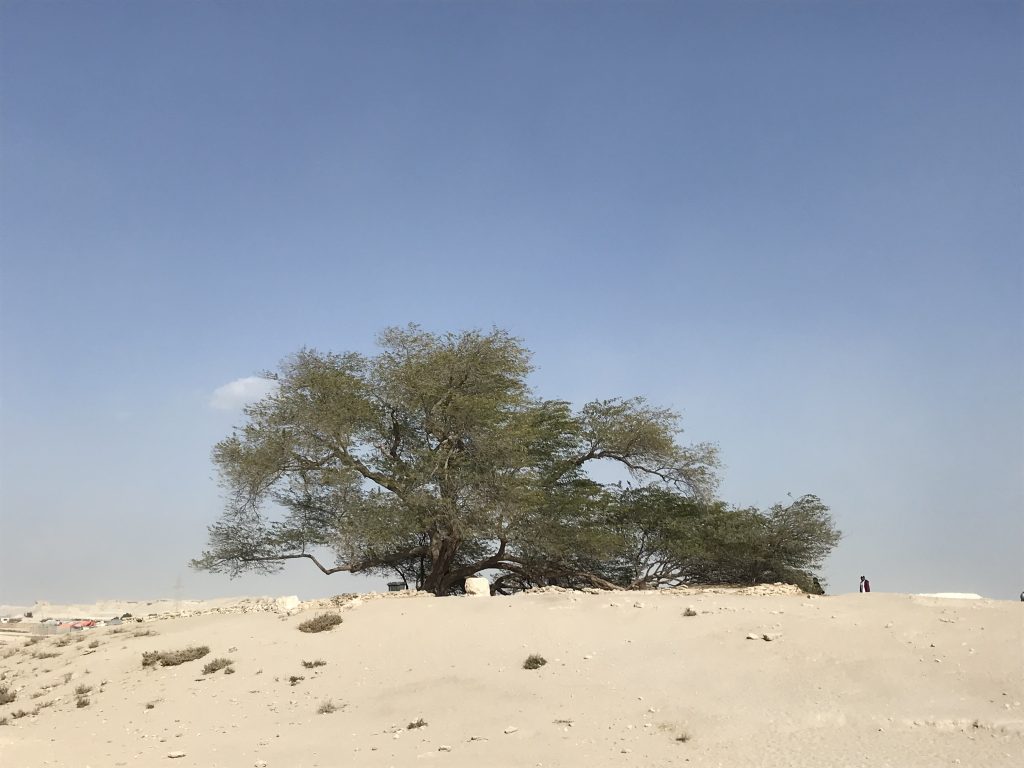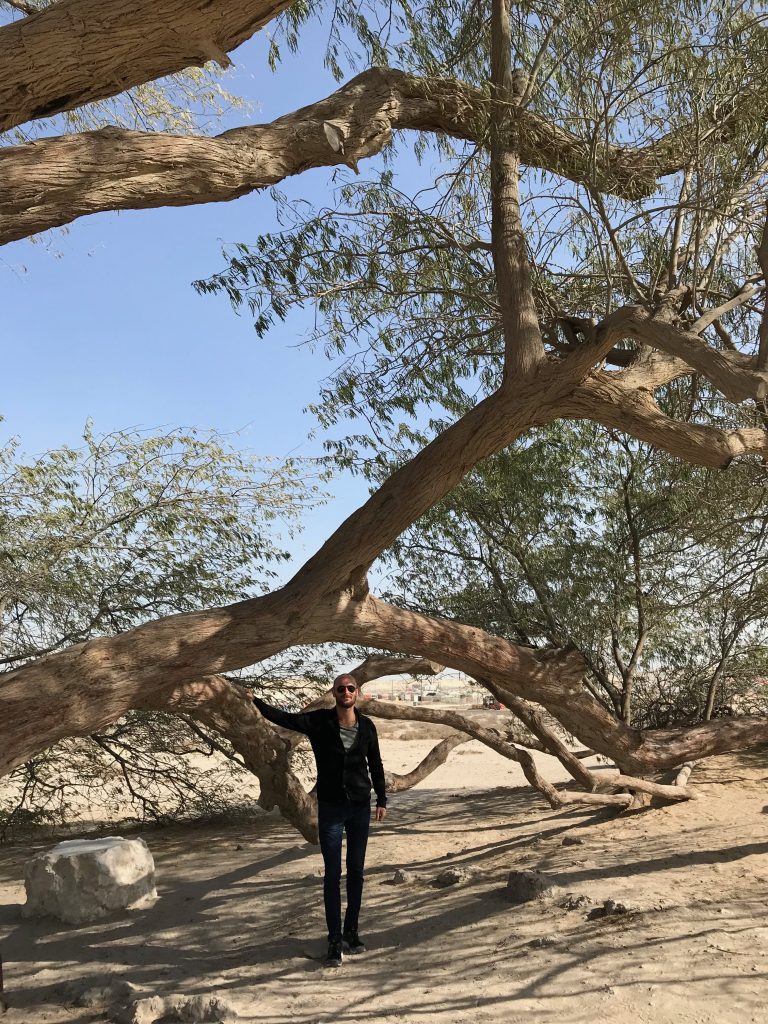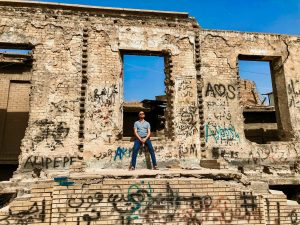Standing proud in the arid, barren desert of a relatively unknown country in the Middle East, is a tree that’s had people racking their brains for almost 400 years: The Tree of Life in Bahrain.
With no lush vegetation around it and no visible water for miles around, it shouldn’t be able to survive. Yet it does and has been done for a miraculous amount of time.
So what makes this Tree of Life stay alive for so long and still go strong? Is it the “real” Tree of Life? (Whatever that means). What do we know about it? Here is a bit of a rundown on this unique piece of vegetation that has kept visitors and locals stumped for hundreds of years.
What is The Tree of Life? (& What is The Fuss All About?)
You might look at pictures of the Tree of Life in Bahrain and wonder what’s so special about this (pretty average-looking) tree. At just 9.75 meters tall, its height is certainly nothing to shout about.
Its age is quite impressive though – living here for four centuries. But that’s not the main reason why everyone wants to make the journey to the middle of the Arabian desert to stare in amazement at this overgrown plant.
Despite being sat in the middle of the empty, inhospitable desert, the Tree of Life, also known as “Shajarat-al-Hayat” locally, seems to flourish.
Green leaves pepper its unruly branches and its roots are full of water. But still, looking around the Tree of Life, there’s no obvious water source, and this isn’t the kind of place where it rains very often, if at all.
Even arid vegetation needs water to survive.
So what’s the secret? And most importantly, what are the claims being made to add to its mysticism?
Where is The Tree of Life Located?
If you’re struggling to pinpoint Bahrain on a map, you wouldn’t be alone. This island nation, which makes up part of the Middle East sits in the Persian Gulf, in waters that separate Saudi Arabia and Qatar. The majority of Bahrain is inhospitable – at least to the modern population – and an incredible 92% of the country is desert land.
Somewhere in the midst of these desolate lands in Bahrain’s southern regions, the Tree of Life sits all by itself at the top of a 7-meter (25-foot) hill. Not far from the highest point in Bahrain, it’s around 40km from Manama, Bahrain’s capital city.

How Old Is The Tree of Life?
No one knows exactly when the Tree of Life in Bahrain came into existence, but common consensus says that it’s between 400 and 500 years old. After a soil analysis took place in the 1990s, scientists concluded that the tree was planted in 1582, but many still contest the exact date, especially deeply religious folk.
How To Get To The Tree of Life
Firstly, you’ll need to find your way to Bahrain itself. Outside of the Middle East, you’ll struggle to find a direct flight to Bahrain International Airport, which is less than 5km away from Manama. If you’re coming from outside of the Middle East, you’ll more than likely need to catch a connection from Dubai or Abu Dhabi.
Once you’ve arrived safe and sound, you’ve only really got one option to visit the Tree of Life in Bahrain; to travel by car.
Renting a car
It’s pretty easy to rent a car in Bahrain, and surprisingly affordable. Companies such as Budget Rent-a-Car and Sixt have outlets on the outskirts of Manama, as well as at the airport, so you can take your pick. I did a quick comparison and found that you can get something like a Kia Picanto for as little as $ 14 USD/day, plus insurance.
Roads are relatively well-kept in Bahrain too, so experienced drivers shouldn’t have a problem navigating their way to the desert. However, it’s worth keeping an eye on other drivers on the road, as standard driving practices seem to be questionable!
The drive shouldn’t take longer than 40 minutes, and Google Maps coupled with street signs does a sterling job of steering you in the right direction.
Organising a private tour
Tours that go exclusively to the Tree of Life in Bahrain are difficult to find although this Bahrain tour operator will allow you to customise your trip. Also, you will be able to find a private driver or private tour that’s willing to get you there for a fee. Prices will vary by group size, but around $80 round trip via car seems the norm.
If you’re eager to join a tour, a visit to the Tree of Life is usually included on full-day tours of Bahrain or half-day tours of the desert. These usually include a stop-off at the Oil Museum and the Sheikh Salman Bin Ahmed Al Fateh Fort too. You’ll need to part with around $70 USD for a half-day tour and around double that for a full day of exploration.
Uber or private taxis
Organising your own taxi is also an option. Uber operates in Bahrain, making ordering a taxi incredibly easy and pointing your driver in the right direction. As the Tree of Life is so far away from Manama, most Uber drivers won’t head out there unless you pay for their waiting time and guarantee a return journey to the city.
Best Time To Visit The Tree of Life
As you can imagine, Bahrain gets HOT. Peak temperatures in the desert exceed 45°C during the summer months and around 37°C in Manama. That pretty much rules out the possibility of visiting in June, July or August – unless you can cope with those kinds of insane temperatures.
If heat is an issue, you’ll probably want to avoid Spring and Autumn too – temperatures don’t dip below 27°C from April all the way to November. So that leaves us with the cool months of winter to explore the Tree of Life in Bahrain comfortably. Temperatures are a manageable 21°C and rainfall is neither here nor there.
No matter what time of the year you visit, you’ll want to avoid the midday heat in the desert, so try coinciding your visit with early morning or late afternoon, for a much more pleasant experience. Sunset at the Tree of Life is particularly beautiful too; ready yourself for some pretty cracking colours dancing on the sands.
Archaeologists’ Findings From The Tree of Life
Over the past decade, the Bahrain government has put increasing efforts into preserving the Tree of Life and understanding its history. In October 2010, a group of archaeologists excavated the site, looking for signs of a previous life. To their amazement, they found 500-year-old pottery and other artefacts in the area that suggested the remains of a military outpost, abandoned in the 16th or 17th centuries.
Possible Scientific Explanations For The Tree of Life’s Survival
There are some scientific theories mulling around as to why the Tree of Life in Bahrain has lived such a long and prosperous life.
The experts put it down to the type of tree: a Prosopis juliflora. Known to cope exceptionally well in arid, humid environments, the Tree of Life has developed an impressive root system that deep dives 50 meters into the sand in search of any type of water source.
Its compound leaves (essentially a leaf with lots of mini leaves coming off it) are also thought to help keep the tree cool and its unique tolerance for salty environments means any water source will suffice.
However, what still baffles scientists is how the tree got here in the first place. Native to Central and South America, it’s impossible that nature brought this tree to this spot by itself. Many think that this particular tree could have been introduced by wandering traders when the island spent some brief years under Portuguese rule.
However, this still doesn’t explain where the roots get their water from. Some say that the roots manage to dig deep enough to reach the salty sea waters below, while others claim that there’s some kind of underwater well nearby.
Still, to this day, no one really knows.
Religious/Spiritual Beliefs About The Tree of Life’s Survival
While the rational thinkers amongst us may believe that we’ve found an answer in science, many others have turned to mythology and religion to explain how the Tree of Life in Bahrain is still standing.
Modern-Day Garden of Eden?
Some theories claim that the Tree of Life in Bahrain was once part of the biblical Garden of Eden. In the bible, the Garden of Eden is described as having its very own Tree of Life which is an Acacia, a tree similar to the Prosopis, that thrives in desert environments.
This theory has neither been confirmed nor denied. However, with multiple countries arguing that they are home to the Tree of Life from the Garden of Eden, it’s dubious. You’ll find similar claims of owning the real Tree of Life in Botswana, Jerusalem, Mexico and Utah.
Gift From The God of Water, Enki
Another mystical theory is that the tree is protected by Enki, the ancient Sumerian god of freshwater (among many other things like wisdom and magic). Legend has it that Enki gave the tree unsurpassed strength, enough needed to endure such harsh conditions in the sparse Arabian desert.
The Sumerians were thought to have lived in Babylonia from 4,000 to 3,000 BC and had strong spiritual beliefs in higher powers. Not much is known about how they lived their life, except that all of their gods were the personification of natural forces, and Enki was held in exceptionally high regard.
Conclusion: Tree of Life (Is It Worth The Hype & Should You Visit)

I never thought I’d find myself writing an article about a deserted tree… yet here I am.
If you also find yourself in Bahrain and you want to get your own look at a tree that both baffles and inspires mankind, make room in your travels for a trip out to see the Tree of Life.
Pre-approved price with a taxi driver who waited for an allotted time was my preference (for $70 USD).
There’s barely anything else to do in Bahrain other than check out the tree, to be honest. There’s nothing else to do at the tree either. No hard sell from any “I saw the Tree of Life Bahrain and all I got was this lousy t-shirt” vendor.
Not even anyone selling water.
Just you, a tree and your imagination.
That being said, it was certainly a much tamer affair than my Sahara Desert experience!
I wholeheartedly adore travelling in the Middle East, however, I didn’t have too much love for travelling in Bahrain (or any of the other oil-rich Gulf States) and although I’m no botanist – I liked this story.
In a world full of information overload, it’s kind of refreshing to not know things for certain. Keeps you young and humble!







